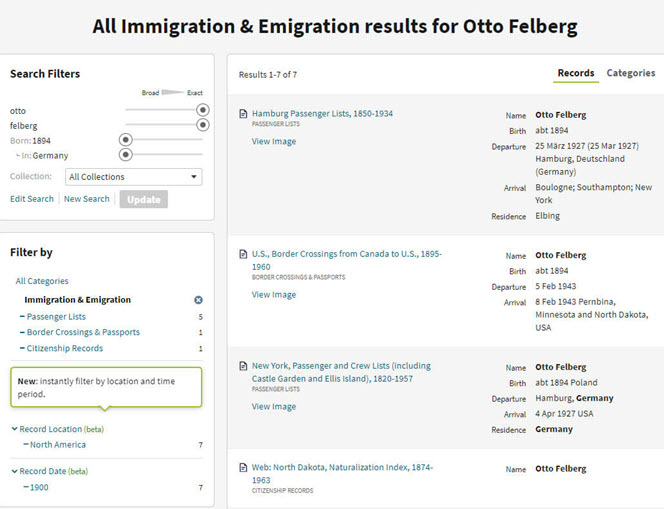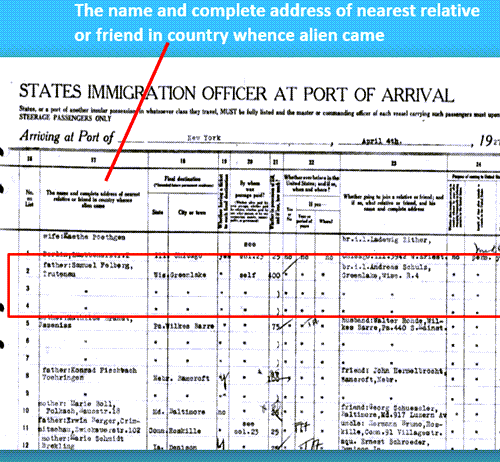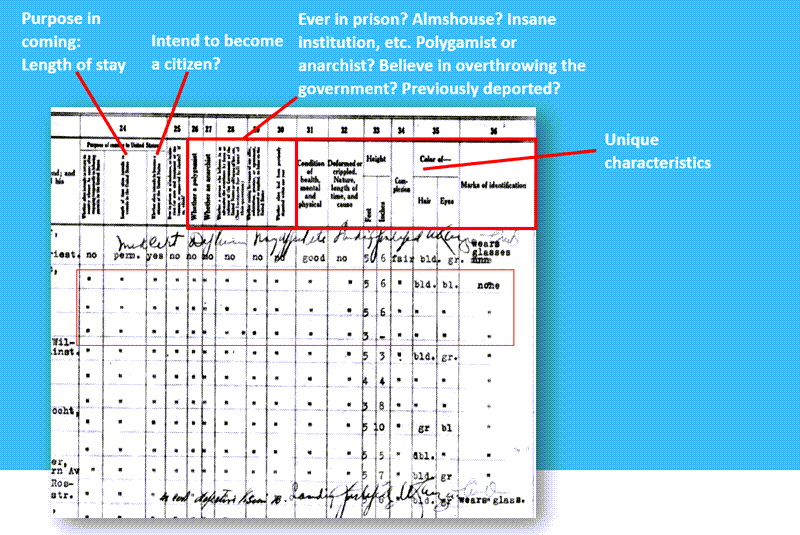How to Find and Decipher Ellis Island Passenger Lists
Passenger Lists Records:
Elevenses with Lisa Episode 34
Video & Show Notes
Original air date: 11/19/20
If you’ve ever struggled to find a passenger list or figure out what it’s telling you about your family history, you’re in the right place. In this episode I’ll show you where to look, and how to interpret what you find. Click to watch the video and follow along with the notes below:
A Question About Passenger Lists
Genealogy Gems Premium Member and Elevenses with Lisa viewer Deborah Huber wrote in about some challenges she was having with passenger lists.
“Hi Lisa, I have a few questions about the passenger records I have found for my mother and grandparents. They are all from Ancestry.com.” Let’s go through Deborah’s questions step-by-step.
Deborah is looking for the Felberg Family:
- Otto age 33 (Grandfather) b. 1894
- Marta age 23 (Grandmother) b. 1904
- Ruth age 3 (Mother) b. 1924
- They Sailed March 25, 1927 from Hamburg Germany to New York
“My mother was born in Heinrichshoff on “Stork Day,” a day celebrating the return of the storks in the spring and welcoming them to their nests on top of the chimneys.”
Passenger List records to look for:
- German Passenger list (the outbound record)
- New York Passenger lists (the incoming record)
Searching for the New York Passenger List
How to search for passenger lists at Ancestry: Search > Immigration & Travel > Search by name and birthdate. If you don’t see both expected passenger lists (ex. Hamburg and New York) check the Card Catalog. Example search: Hamburg passenger or Germany passenger. From the results page you might have the opportunity to click through and see a photo of the ship. You may also find a link to additional passenger lists (in this case, the Hamburg Passenger List).

Results page for Otto Felberg
Question: “Also, my mother always said that they didn’t go through Ellis Island but did land in NY City. I think Castle Gardens was already closed in 1927 so I’m trying to figure out where they did land.”
Answer: The record collection title alerts us to what is included in the passenger list collection: New York, Passenger and Crew Lists (including Castle Garden and Ellis Island), 1820-1957
A quick Google search will tell us the dates that Castle Garden was in operation: “From August 3, 1855 to April 18, 1890, Castle Garden was America’s first official immigration center, a pioneering collaboration of New York State and New York City.”
Tip: Search Multiple Sources for Passenger Lists
You may find the quality of the digitized image varies from one genealogy website to the next.
Top Free Resources for searching for Ellis Island passenger lists:
- Ellis Island Passenger List Search at the Statue of Liberty-Ellis Island Foundation, Inc. Website: https://heritage.statueofliberty.org/passenger
- Stephen Morse: https://stevemorse.org/
- FamilySearch
Tip: Finding Passengers When Names are Hard to Read
When names are difficult to read, focus on other information that is easier to spot such as the person’s age. In the Felberg family’s case, Ruth was 3 years old. Looking for a “3” in the age column proved much easier than reading the names.
Identifying the Location Named in a Passenger List
Question: On the screenshot from the Hamburg list is says the destination was “Greenlake”. Is that a port? All I could find on the internet about Greenlake is that it is a NY state park.
Answer: The “Greenlake” mentioned in the indexed passenger list record refers to the final destination, not the port of arrival. Carefully review both original passenger list records.
Tip: Don’t Miss Page 2
Like many genealogical records, passenger lists records may be more than one page. If the index refers to something that you do not see when you click through to the original record, it is a strong indication that there is another page. Always look at the pages before and after any digitized record. In this case, we find Greenlake, WI on page 2!
- 1820 – 1907: Ship manifests are 1 page in length
- After 1907: Manifests are 2 pages with additional information provided.
Source: The Statue of Liberty – Ellis Island Foundation, Inc.
Now that we know that Greenlake is Greenlake, Wisconsin, we can run a quick Google search to find the correct name and county: Green Lake, Wisconsin. Then continue your googling to find more historical information such as old maps and postcards. Click “Images” on the results page to quickly review the results.
Here are a few of the resources we found for Green Lake, WI:
Deciphering the Passenger List
There is a wealth of information on the Felberg’s passenger list, starting with the name of Otto’s father and the town where he lived:

Nearest relative listed on a passenger list

How to decipher an Ellis Island passenger list form.
Hamburg Passenger Lists
Question: “I can’t read the actual document which is the Hamburg Passenger List.”
Answer: The Hamburg passenger list can be found in the Card Catalog. Card Catalog > Search Title (Hamburg Passenger Lists)
2 results: the passenger lists and the index.
We discovered that not only was the passenger list extremely difficult to read due to the ink copying over the page, but also the link did not go to the correct page. This is where the Index, found through the Card Catalog, because indispensable.
Index: Hamburg Passenger Lists, Handwritten Indexes, 1855-1934
- 1925-1934 (The Felberg’s arrived in 1927)
- Band 161 (1927 F-J) (The year of their arrival and “F” for Felberg)
- F (for Felberg)
Search the Index to locate the page number for the passenger’s record. Then go back to the original record and find the handwritten page number in the upper corner.
Tip: Quickly Navigate the Ancestry Record
Simply press the appropriate key on your computer keyboard to quickly navigate the pages.
“N” = Next page
“P” = Previous page
Visit Elevenses with Lisa Episode 17 for more Ancestry search tips and tricks.
We found the Felberg family on page 117, exactly where the index said they would be. It’s a good idea to search all the passengers for others with the same last name. In this case, Otto’s brother Rudolph Felberg was also on the ship. This aligned with the family lore that Rudolph may have sponsored the family’s move.
Resources:
- Genealogy Gems Podcast episode 211 With Barry Moreno, Historian at Ellis Island.
Premium Member Bonus Downloads (Membership required – learn more here):
- Download the show notes handout (ad-free).
- Download the exclusive Ellis Island Passenger Lists Quick Reference Sheet
- Genealogy Gems Premium Podcast Episode 153 Jackie Schalk, Director of the American Family Immigration History Center at The Statue of Liberty-Ellis Island Foundation, Inc discusses clues you may find in US passenger lists.
Free Genealogy and DNA Video Presentations Now Available from MyHeritage
The second annual MyHeritage user conference, MyHeritage LIVE 2019, was held in Amsterdam.
Below you’ll find a list of lectures from the conference which are now online. These sessions, given by world-renowned experts and valued MyHeritage staff, are now available on MyHeritage Education.
If you missed the conference or the live stream, you can now take watch these video recordings for free, from the comfort of your own home, at any time, and at your own pace.
Pick from this List of MyHeritage Video Classes
Here is a list with a full description of each and links to watch them:
Opening Session: Keynote by MyHeritage Founder and CEO Gilad Japhet
In his keynote address at MyHeritage LIVE, MyHeritage Founder and CEO, Gilad Japhet, talks about recent MyHeritage achievements as well as upcoming features and projects
What’s New at MyHeritage
with Maya Lerner
Maya Lerner, VP of Product at MyHeritage, gives a summary of MyHeritage’s new features and a look ahead at future plans.

Introducing the New Educational Resource Center for MyHeritage Users
with Daniel Horowitz
This presentation will give you an inside look at MyHeritage Education, a new online resource center for enhancing your understanding of the MyHeritage platform.
Hear my interview with Daniel Horowitz in Genealogy Gems Podcast episode #221.

Searching and Browsing on MyHeritage to Get the Most Out of Your Research
with Cyndi Ingle
With 10 billion historical records, MyHeritage is able to provide the most extensive genealogy searches available on the Internet. Learn how to use them efficiently to find new and relevant information to incorporate into your research.
Discovering Immigration Stories with MyHeritage
with Lisa Alzo
Every immigrant has a story. Learn how to leverage the immigration records collection at MyHeritage to uncover key clues and make amazing discoveries about your immigrant ancestors from both sides of the pond.
Lisa Alzo has been a guest blogger here at Genealogy Gems. Her articles include Heritage Receipts – Aunties, Sprinkles and the Santa-in-his-cap cookie cutter and 4 Steps to Getting Started with Scrivener Software for Writing Family History.
Using MyHeritage to Find Ancestors from the Netherlands
with Yvette Hoitink
If you have ancestors from the Netherlands, this talk introduces you to the most important records and shows you what you can find online, even if you don’t know any Dutch. Learn how naming traditions and emigration patterns can help you find your Dutch ancestors.
PANEL: Researching Dutch Family History Around the World
These experts give tips and advice on how to research your roots in Surinam and the former Dutch East Indies.
Evaluating Your Smart Matches™ and Record Matches on MyHeritage
with James Tanner
Smart Matches™ and Record Matches on MyHeritage supercharge your research. Learn how to review and evaluate these automatically generated matches and effectively use them to advance your genealogical research goals.
An Overview of Western European Record Collections on MyHeritage
with Mike Mansfield of MyHeritage
With over three billion records from thousands of collections of European origin and a vibrant user community, MyHeritage is an incredible resource for European research. This session will provide an overview of these collections and highlight how to best find access and utilize these sources.
Using Geni and How it is Different from Other Genealogy Platforms
with Mike Stangel
Learn more about the benefits of collaboration in a single-family tree, including adding sources to shared profiles, communicating with public discussions, understanding the revision history of profiles, and working with projects. Learn how Geni and MyHeritage work together to help improve the quality of the World Family Tree and connect you to new relatives.
Top Technology Tips for MyHeritage Users & Introduction to Family Tree Webinars
with Geoff Rasmussen
Developing Your Own Research Plan on MyHeritage
with James Tanner
MyHeritage provides an extremely valuable platform for conducting systematic and source-based research. A formal research plan can help you organize all the information presented in a coherent, useful way, and keep you moving towards your genealogical goals.
Using Census, Immigration, Newspaper, and Yearbook Records at MyHeritage to Explore the LIves of Your Ancestors
with Lisa Alzo
In genealogy, cluster and collateral research is a key strategy for solving complex brick wall problems. Learn how to use census, immigration, newspaper, and yearbook records at MyHeritage to explore the lives of your ancestors and their inner circles.

Science for the Non-Scientist: How Does MyHeritage Produce their DNA Results?
with Diahan Southard
DNA test results are a companion to our other research methods. A better understanding of how it all works will lead to better use of the tools for your family history research.
Diahan has been a regular contributor here at Genealogy Gems. Read her article Adoption DNA Match Strategy: Combine DNA Test Types.
Click the video player below to watch my conversation with Diahan about common genetic genealogy misconceptions:
What Exactly is a Centimorgan? An Introduction to the Science of DNA Testingwith Ran Snir
Whether you have already taken a DNA test or this is the first time you’re hearing about it, in this session we will start from the very beginning. We’ll go over the basic terms of DNA testing and learn how DNA is passed down through generations, how and why individuals have shared DNA segments and how we’re able to estimate one’s ethnicity origins.
Ran Snir was featured in Genealogy Gems Podcast episode #227. Click here to hear my interview with him on the Theory of Family Relativity™.
Mapping Your DNA Matches on MyHeritage
with Blaine Bettinger
Learn about useful tools to organize your list of DNA Matches, how to differentiate between them, and how to better utilize each tool.
Using the Theory of Family Relativity™ to Research Your DNA Matches
with Ran Snir
Learn about the revolutionary technology that saves you dozens of hours of research by synthesizing billions of data points to craft multiple theories about how you and your DNA Matches might be related.
PANEL: The Future of DNA Testing
Roberta Estes, Blaine Bettinger, Yaniv Erlich
This panel of DNA experts discusses the current state of DNA testing and what the future will bring.
Formulating a DNA Testing Plan
with Blaine Bettinger
DNA testing can be expensive, but DNA evidence is a component of exhaustive research when it is available. Identify some of the ways you can minimize costs while maximizing results by formulating a DNA testing plan early in your research.
Why You Should Complement Your DNA Data with Genealogy Research
with Diahan Southard
Building a family tree is free and adds a lot of value to your DNA test. Learn how it can help improve the accuracy of relationship estimates, trace common ancestors to uncover how exactly you are related, increase the chances DNA Matches will contact you, help you identify the family members whose DNA results would contribute the most value to your research, and more.
The World Wide DNA Web
with Alon Diament Carmel
Alon Diament Carmel, Ph.D., researcher for the MyHeritage science team, explains what we can learn from the vast web billions of DNA Matches about genetic groups and identity.
Introducing the MyHeritage DNA Health+Ancestry Test
with Yaniv Erlich
Discover how your genes affect your health and explore the valuable insights you can gain from this latest addition to our DNA product line. The MyHeritage DNA Health+Ancestry test gives you dozens of personalized health reports that explain your genetic risk for developing certain conditions, and tell you whether you’re a carrier for hereditary conditions that can potentially be passed on to your children.
PANEL: DNA Testing for Health
with Yaniv Erlich, Diahan Southard, Roberta Estes
This panel of DNA experts discusses the advantages of taking a Health DNA test to learn more about how your genes may affect your health and empower you for the future.

